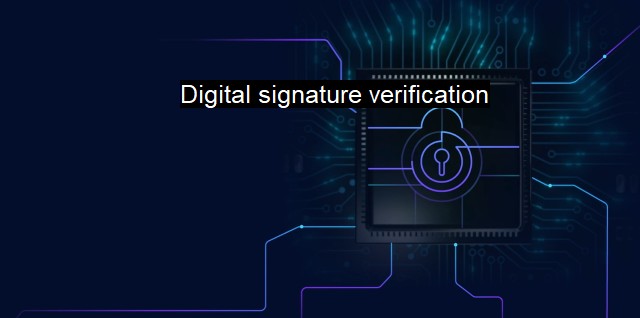What is Digital signature verification?
Ensuring Data Security in the Digital Age Through Digital Signature Verification: Understanding the Algorithms and Analytics
Digital signature verification is a critical cybersecurity process optimized for authenticating digital documents or messages. Reminiscent to literally stamping a seal of approval on an envelope's contents, digital signatures provide an additional layer of intrinsic security to safeguard the integrity and authenticity of data while being transmitted over the internet. Ideal for cross-stitching digital identity, authenticity, and integrity with advanced levels of encryption, these signatures are basic constituents of contemporary cryptographic protocol suites. Today's world is populated by an ever-evolving digital atmosphere, thereby making technologies such as digital signature verification extremely pivotal in safeguarding personal and organizational data.Digital signature verification establishes the veracity and authenticity of a digital communication, binding the sender's identity to it, thereby providing a guarantee that the message's content has not been tampered with during transmission. Without it, it would be considerably more challenging to verify the authenticity and trustworthiness of digital communications.
Digital signatures work by using two different but mathematically connected, keys: a private key and a corresponding public key. The private key, first and foremost, is confidential and used to mathematically generate the digital signature, eponymously considered the signing key. The corresponding public key, generally available in a directory, is handy in terms of the mathematical verification of the signatures and the message received, thereby known as the verification key.
Signature creation is generally a two-step process. Firstly, algorithms along the lines of SHA (Secure Hash Algorithm) proceed by creating a message digest of the original data. This message digest or hash, constituting a one-way function, is a fixed size alphanumeric string. Consequently, even tiny alterations to the data yield deeply different hash values. Secondly, digital signatures harness the creator’s private key for encrypting this hash. The resultant encrypted hash is none other than the digital signature itself. A realistic, process-informed insight attests to the fact that the private key cannot stoically digest a denatured, altered message when compared to such original profundity.
Conversely, the process of signature verification entails decrypting the signed hash using the public key formidably prescribed to the original agonic signatory. In parallelity, the receiver’s system operates a robust hash function on the received message, creating a new hash value. If the new hash coincides and is identical to the signer’s original decrypted hash, such authenticates the propreity of both the sender’s identity and the impeccability of the message.
In retrospect, despite antivirus software and cybersecurity practices fortifying an array of different devices, they can unwittingly succumb to the security vulnerabilities should they encounter digitally-signed malware. Digital signatures equip an adventitious sense of legitimacy to the recorded documents. This is due to mirrored sedation in the open zones exhibiting an anti-malware system’s inequality. fraudulent signatures or deviant processes can gull under-equipped defense mechanisms, masquerading under the cloak of legitimate digitally signed documents and verily making way for the unsuspicious installation of malware on the target systems.
While traditional forms of signature verifications are susceptive to forgery and replication, the digital signature’s verification process is inherently secure due to the use of cryptographic keys that are difficult to counterfeit. A comprehensive blend of superior encryption algorithms, robust cryptographic keys at various layers, and trusted third-party certification authorities aid in victoriously averting incidents of fraud and theft.
Digital signature verification plays a central role in enforcing the seamless sustenance of secure digital communications today, treading the rocky road of combatting an immaculate host of security threats, fraudulently aspiring malware, and systemic thefts. As components of advanced cryptographic techniques, they take a primary responsibility for instituting a strong security foundation for a range of applications, realizing a cyber world of trust, integrity, and assured expectation.

Digital signature verification FAQs
What is digital signature verification?
Digital signature verification is the process of ensuring the authenticity of a digital document or message by validating the digital signature attached to it.What is the purpose of digital signature verification?
The purpose of digital signature verification is to prevent tampering, alteration or forgery of digital documents and messages, and to ensure that they are sent by the claimed sender.How does digital signature verification work?
Digital signature verification involves checking the validity of the digital signature by verifying the digital certificate, public key and signature algorithm used to create the signature. This helps in ensuring that the digital document or message has not been altered or modified since the time it was signed.What are the benefits of digital signature verification in cybersecurity and antivirus?
Digital signature verification plays a crucial role in ensuring the integrity of digital documents and messages, and helps in protecting against cyber threats such as phishing, malware, and identity theft. By enabling digital signature verification, antivirus software can detect and prevent any attempts of unauthorized access, modification, or distribution of digital documents and messages.| | A | | | B | | | C | | | D | | | E | | | F | | | G | | | H | | | I | | | J | | | K | | | L | | | M | |
| | N | | | O | | | P | | | Q | | | R | | | S | | | T | | | U | | | V | | | W | | | X | | | Y | | | Z | |
| | 1 | | | 2 | | | 3 | | | 4 | | | 7 | | | 8 | | |||||||